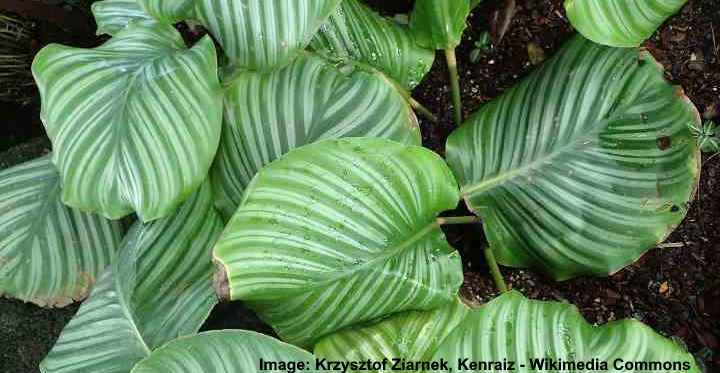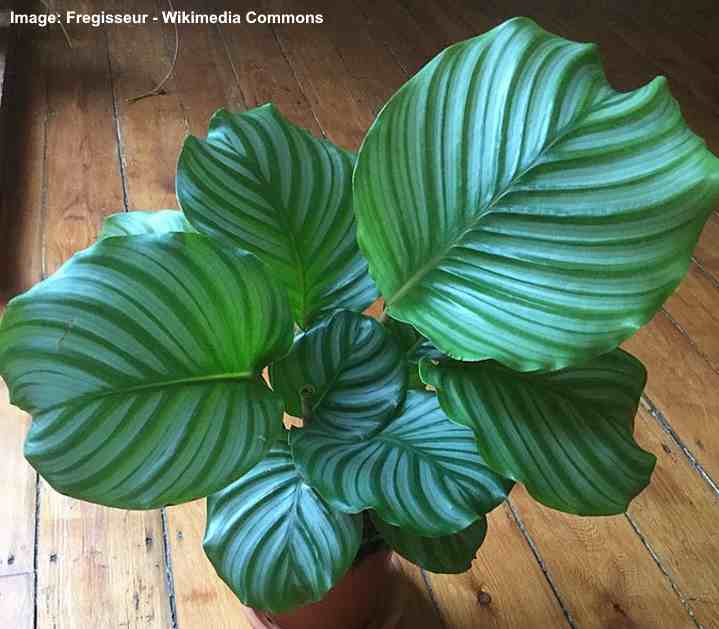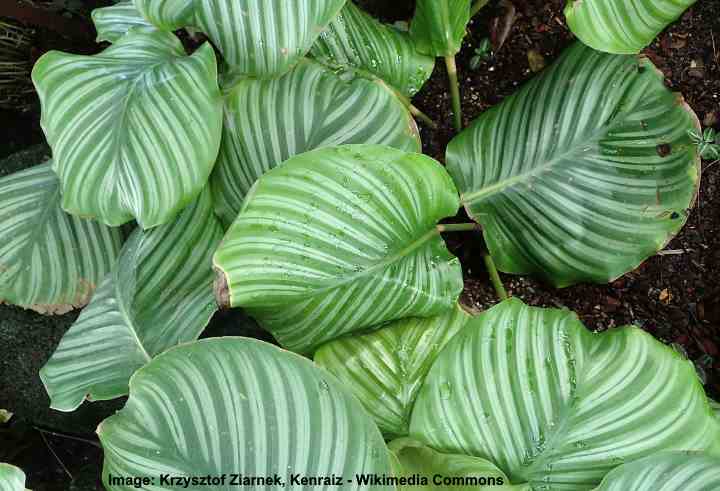Calathea Orbifolia Care and Growing Guide (With Pictures)

The Calathea orbifolia is a species of tropical plant that is commonly grown indoors. The reason why calatheas are common houseplants is due to their enormous, showy, decorative leaves. Calathea orbifolia plants have large, silvery-green leaves with pronounced dark-colored veins. Although this calathea species grows well at home, there are a few care essentials to help the plant thrive.
How to care for Calathea orbifolia: Growing indoors, Calathea orbifolia thrives in medium indirect light, high humidity, and temperatures ranging between 65°F and 75°F (18°C – 24°C). Grow in well-draining potting soil and keep it moist by watering when the top 1” to 2” (2.5 – 5 cm) of soil dries. Fertilize monthly during the growing season.
The Calathea orbifolia is a flowering species of plant in the family Marantaceae. The perennial plants are native to tropical forests in Central and South America, Asia, and Africa. Outdoors, calatheas grow on the forest floor, where they thrive in shaded, warm, humid environments.
The Calathea orbifolia has a moderately-fast growth rate indoors. Eventually, the exotic houseplant can reach 3 ft. (0.9 m) in height. The striking glossy leaves can grow up to 1 ft. (30 cm) wide.
Sometimes calatheas are called prayer plants because they raise their leaves at night like prayer plants. In the evening, the leaves of calathea plants fold upright at the base of the stem, as if the plant is folding its leaves upward to pray. This process is called nyctinasty.
Calathea orbifolia, just like prayer plants, are stunning indoor tropical plants with showy foliage.
In this article, you will find the best way to care for a Calathea orbifolia indoors. At the end of the article, learn how to resolve many issues associated with growing this species of Calathea.
Calathea Orbifolia Care Guide
Also classed botanically as Goeppertia orbifolia, the most critical care requirements for Calathea orbifolia are adequate indirect light, proper watering, and well-draining soil. Get this right, and your calathea houseplant will thrive, not just survive.
Calathea Orbifolia Light Requirements

Grow your Calathea orbifolia in medium to low indirect light
Your Calathea orbifolia needs to grow in medium to low light, protected from direct sunlight. You can tell if the light is adequate if you can read without straining your eyes. If the light is too bright, the leaves will start to fade, and they may even wither and die.
Although these calathea plants can survive in low light, they are not classed as plants for dark places. They’ll grow well on a north-facing windowsill or placed near an east-facing window. In rooms that face to the south and west, keep well away from the window in a shaded corner.
Other types of calathea, such as the Calathea Medallion and Calathea Ornata, grow better in bright, indirect light.
The Best Type of Potting Soil for Calathea Orbifolia
Calathea orbifolia thrives when growing in fertile potting soil that has excellent drainage. The soil should retain some moisture, but never become soggy. The best ingredients for a calathea potting mix are two parts potting soil, one-part perlite, and one-part orchid bark. Organic matter holds moisture, and perlite provides drainage.
One advantage of using peat-based soil is that it contains essential nutrients for calatheas to thrive. This type of organically-rich growing medium is better than using chemical fertilizers. However, peat can become compacted in time, so it’s always good to check that water drains freely.
Perlite or pumice are better soil amendments than vermiculite for increasing drainage. Although all these are natural products, vermiculite tends to hold too much moisture. If roots get too damp, or soil becomes waterlogged, you’ll have problems with root rot.
How to Water Calathea Orbifolia

Water Calathea orbifolia only when the top soil has dried out
Water Calathea orbifolia as often as the top layer of soil dries out. This houseplant watering technique ensures that you never overwater your plant. To know when to water your orbifolia, press the soil. Hints of moisture mean you should hold off watering—water when the soil is partially dry.
Although not a type of drought-tolerant indoor plant, orbifolia plant withstands periods of dryness better than overwatering.
In summer, you might have to water the plant once a week or even more frequently.
A common mistake when it comes to Calathea orbifolia care is to water on a regular schedule. This habit tends to result in watering the plant too often. So, always use soil moisture levels as a watering guide.
When watering your Calathea orbifolia, drench the soil until water drains from the holes in the pot’s base. Allow all the excess water to drip out entirely before putting the pot back on the drip tray. Check the saucer occasionally to make sure the pot doesn’t sit in water.
Remember that you need to water Calathea orbifolia plants more often in summer than in winter. Warm temperatures cause moisture to evaporate faster than in winter. However, in winter, you may have to mist the leaves more frequently than watering. Calatheas love high humidity, and central heating tends to cause dry air.
Calathea Orbifolia Temperature Needs
Average room temperatures are ideal for growing Calathea orbifolia houseplants indoors. Keep an even temperature between 65°F and 75°F (18°C – 24°C), and your tropical plant should thrive. If temperatures are too high, the leaves will start to curl. Too low, and the large glossy green leaves will droop.
The challenge of growing calatheas indoors is caring for them properly in summer and winter. Calatheas are sensitive to sudden temperature changes. So, keep them away from cold drafts, such as the air-conditioner airflow or open windows. In winter, make sure and keep the orbifolia plant pot far away from radiators.
Calathea orbifolia plants can grow outdoors in containers in summer. As long as the temperature never drops below 60°F, the potted tropical plant can grow in a shaded spot in your backyard. Remember to protect your plant from direct sunlight and water only when the top layer of soil has dried out.
How Much Humidity Does Calathea Orbifolia Need?
Native to tropical habitats, calatheas such as Calathea orbifolia need high humidity of at least 50 percent. Usually, average room air moisture levels are too dry for calatheas. You’ll need to mist the leaves, place on a pebble water tray, or use a room humidifier to keep your orbifolia plant happy.
An ideal location for calatheas is in a well-lit bathroom or a kitchen. These excellent shower plants thrive in the humid environment and filtered sunlight that many kitchens and bathrooms have.
Here are some care tips when it comes to proper humidity for calatheas:
- Misting—Only use filtered tap water or distilled water to mist the broad shiny leaves. For best results, humidify every other morning by creating a fine mist over the large leaves.
- Wipe the leaves—Once a week, wipe the leaves with a damp cloth. This technique not only provides moisture but helps to clean the beautiful Calathea orbifolia leaves from dust.
- Pebble tray—Fill a large deep dish with a layer of small stones and then add water until it reaches halfway up the stones. Place the calathea pot on the pebbles so that the leaves get moisture when water evaporates.
- Room humidifier—If you have many tropical house plants, a room humidifier can help keep air moisture levels just right.
- Group plants together—All plants give off moisture—a process called transpiring. Putting your plants together can help create a humid environment for them to thrive.
Fertilizing Calathea Orbifolia for Best Growth
Plants in the genus Calathea don’t require a lot of feeding. During the growing season, light monthly fertilization will provide the minerals and nutrients your orbifolia plant needs. Use an organic houseplant feed and dilute it to one-quarter strength. Stop feeding during the fall and winter.
Calathea orbifolia benefits from a balanced, regular fertilizer for houseplants. However, you should remember to flush the soil every so often. Too much fertilizer in the soil can burn the sensitive orbifolia roots. Giving the soil a good drenching between feeding prevents a buildup of excess minerals.
Calathea Orbifolia Growth Rate
Under the right conditions, orbifolia plants have a medium growth rate. For the fastest growth, make sure the calathea grows in bright indirect light and hydrate it just enough to keep the soil slightly moist. Most Calathea orbifolia plants grow to about 2 ft. (0.6 m), but some can become taller.
The luscious, glossy oval-shaped leaves grow to about 30 cm wide. These broad houseplant leaves are excellent for absorbing light, which makes them plants suitable for low-light conditions. However, in dim light, the plant’s growth rate will slow considerably.
How to Prune Calathea Orbifolia
Calathea orbifolia plants have minimal pruning requirements. Single-leaved stems make up the bushy foliage. Therefore, the only reason calatheas need pruning is to trim off dead foliage to improve the plant’s appearance. Pruning orbifolia plant is also useful for removing old yellowing leaves.
Calathea Orbifolia Propagation
Propagating indoor Calathea orbifolia plants is challenging. Calathea propagation from cuttings or root division is notoriously tricky and rarely successful. From all of the calathea propagation methods, rhizome division is usually the easiest. Orbifolia plants get stressed when disturbed. If you don’t divide the roots correctly, the plant could die.
The best time to propagate a healthy Calathea orbifolia is in spring when growth is vigorous.
Here is the calathea orbifolia propagation method:
- Gently ease the root ball from the pot and remove the dirt from the roots.
- Using a sterile blade, cut a piece of the tuber with at least one stem and leaf.
- Repot in a suitable potting medium.
- Keep the new plants in a warm, bright spot and mist every day.
Repotting a Calathea Orbifolia
It is usually enough to repot your orbifolia every two years. Generally, the Calathea orbifolia doesn’t like getting repotted, but it doesn’t grow well if it’s rootbound. Repotting calathea plants allows you to refresh the potting soil, check the roots for signs of rot, and transfer to a larger container.
When repotting a Calathea plant, it’s crucial to avoid disturbing the roots too much. Here the steps to repot an orbifolia:
- Pick a pot that is about 2” (5 cm) larger than its current one.
- Remove the root ball and carefully check the roots for signs of decay—brown and mushy roots.
- Half-fill the new container with appropriate calathea potting soil and put the plant in.
- Then lightly fill the rest of the space with the remaining soil.
- Thoroughly water the orbifolia and put it in a warm shaded place.
Calathea Orbifolia Flowers
In the wild, Calathea orbifolia blooms with clusters of delicate white flowers on the ends of stems. The flowers have small petals that are in the shape of a star. These grow sparsely to form a flower head.
Orbifolia rarely—if ever—flowers indoors. Most people keep these species of Calathea for their over-sized, striking silvery-green foliage with dark veined patterns.
Pests and Diseases Affecting Calathea Orbifolia Care
The humid, damp growing conditions required for these calatheas make them prone to insect infestations and fungal diseases. Powdery mildew, white soil mold, and leaf spot can all affect the plant’s growth. Also, mealybugs, thrips, aphids, and whitefly are common plant pests that can affect the plant’s growth.
Proper watering techniques can help to reduce instances of fungal disease. This is another reason to always water the plant when 1” to 2” (2.5 – 5 cm) of the top soil is dry. Also, cold, humid conditions put the calathea at risk of fungal root decay.
Always check for signs of indoor plant pests when you water your plants. Here are the signs to look for:
- Mealybugs—These sap-sucking pests look like bits of white candy floss on stems and under leaves.
- Aphids—Look for tiny translucent, pear-shaped bugs on stems and leaves. Leaves may look wilted and distorted, and there could be sticky honeydew on the plant.
- Thrips—These houseplant pests are difficult to spot. They are slender flying insects that look like minuscule dark slivers on the underside of plant leaves.
Please read this article on how to get rid of houseplant pests naturally if you think that you have an infestation.
Calathea Orbifolia Toxicity
The ASPCA says that orbifolia plants aren’t toxic to cats, dogs, or other household pets. (1)
FAQs About Calathea Orbifolia Care
Caring for Calathea orbifolia can be challenging for houseplant owners. It’s essential to get growing conditions just right to avoid common care issues. So, if your calathea is drooping and the leaves are discolored, read on to find out what to do.
Why are brown leaf edges appearing on my Calathea orbifolia?
Low humidity and underwatering are usually to blame for brown Calathea orbifolia leaves. You might notice brown crispy edges or brown patches on the large green leaves. To resolve problems of brown calathea leaves, mist the leaves regularly and water the plant whenever the soil has partially dried.
Another cause of unsightly brown patches on calathea leaves is thrip infestations. You’ll have to remove the pests and then prune the damaged leaves.
Why do Calathea Orbifolia leaves turn yellow?
Yellow calathea leaves are usually a sign of incorrect watering—either watering too often or not watering enough. However, if you are giving the calathea the right amount of water, temperature fluctuations could be to blame. Keep the tropical indoor plant away from drafts or radiators to prevent yellowing leaves.
Why are Calathea Orbifolia leaves curling?
Too little moisture or cold temperatures can cause Calathea orbifolia leaves to curl. If the plant is stressed due to cold, dry air, the leaves can curl so much that they resemble tubes. To solve the curling leaf problem, move to a warmer, shady location, and mist a regularly.
Why Calathea Orbifolia leaves have started drooping?
As with most houseplants, drooping leaves of Calathea orbifolia can be a sign that the plant is lacking water. Check the soil for dryness 2” (5 cm) below the surface. If the potting mix is dry, give the orbifolia plant a thorough soaking to help revive it. Water whenever the top layer of soil dries.
Another more serious issue that can cause leaves to droop is root rot. Potting soil that is overly damp and soggy can result in roots becoming mushy and useless. The best resolution would be to repot the plant in a sterile, moist potting medium and prune off any dead roots.
Why are my Calathea Orbifolia leaves wilting after repotting?
Calathea orbifolia indoor plants get stressed when repotting them. After transferring to a new container, it’s common for leaves to wilt. The best way to solve this care issue is to place the plant in a bright, humid place. Avoid fertilizing, pruning, or repotting until the plant looks better.
How to revive a dying Calathea Orbifolia?
If your calathea looks like it’s dying, you need to discover the underlying cause. First, check the potting medium for too much or too little moisture. If the soil seems good, carefully inspect under the leaves for signs of pests and treat the infestation as necessary.
Discover other amazing types of Calatheas:
- The Most Beautiful Types of Calatheas (With Growing Instructions)
- Calathea Ornata (Pinstripe Calathea)
- Calathea Medallion: Care, Plant Profile and Growing Tips
Related articles:
